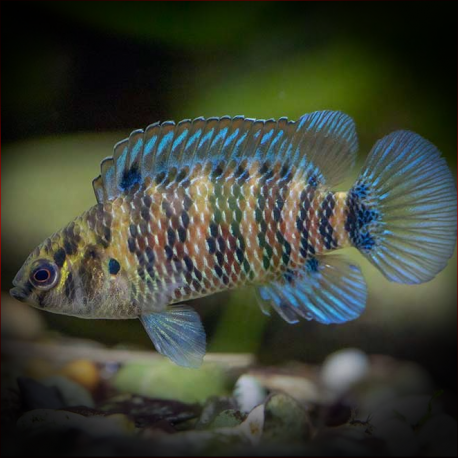More info
Datasheet
| Minimum Tank Size | 60 litres / 15.85 US gallons |
| Maximum Size | 8.5cm / 3.35inches |
| Temperature | 20°C / 68.00°F - 24°C / 75.20°F |
| Hardness | 5.04dgH / 90ppm - 10.03dgH / 179ppm |
| pH | 6.5-8.4 |
General Description
The Badis tuivaiei is a species that was first collected in the Tuivai and Irang rivers in northeastern India, displaying similarities to other species within the Badis genus such as B. badis, B. chittagongis, and B. kanabos. It can be identified by specific morphological characteristics like interorbital width, body depth, scale counts, and vertebrae numbers.
Aquarium Setup
For optimal thriving conditions, Badis tuivaiei should be housed in a well-structured aquarium with a sand or gravel substrate, water-worn rocks, and plenty of cover provided by plants like Microsorum or Anubias. Cave-like structures are essential for potential spawning sites, with floating plants and leaf litter adding a natural feel. The tank should have gentle filtration and subdued lighting.
Behaviour
Due to its rarity in the hobby, emphasis on captive reproduction is crucial when maintaining Badis tuivaiei. This species is not gregarious and can be aggressive towards rival males, especially in smaller tanks. It is recommended to keep them alone or in pairs to avoid conflict. They are slow-moving, deliberate feeders who may struggle with larger or more boisterous tankmates for food.
Feeding and Diet
Badis tuivaiei are micropredators, feeding on small aquatic crustaceans, worms, insect larvae, and zooplankton. They may be picky eaters initially, preferring live or frozen foods like Artemia and Daphnia. It is essential to avoid chironomid larvae and Tubifex in their diet to prevent obesity and susceptibility to diseases.
Reproduction & Dimorphism
Breeding Badis tuivaiei in captivity involves cave spawning and the formation of temporary pair bonds. Rival males become combative during breeding season, displaying courtship behavior towards females. Females are smaller and have duller patterning compared to males, who develop extended finnage. Males take sole responsibility for guarding the eggs and fry post-spawning.
Habitat and Distribution
Badis tuivaiei is native to the Tuivai and Irang rivers in northeastern India; additional collections have been made from the Wahumiam River in Meghalaya. They inhabit shallow, slowly-moving, clear waters with rocky substrates and forested surroundings. The Barak River system and the Ichamati River play significant roles in its distribution within the region.

